【最新】语言学Morphology
- 格式:ppt
- 大小:2.29 MB
- 文档页数:33
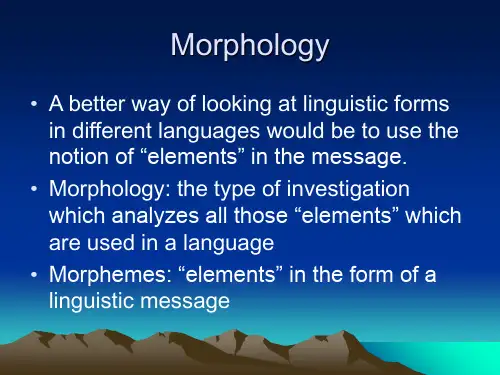
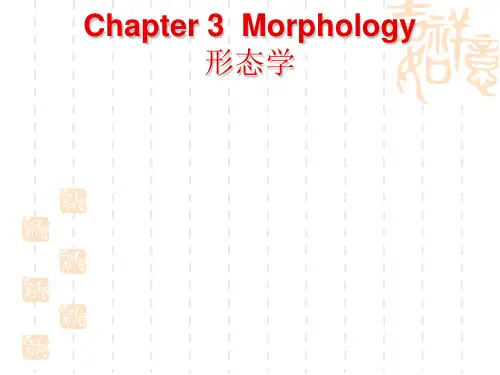
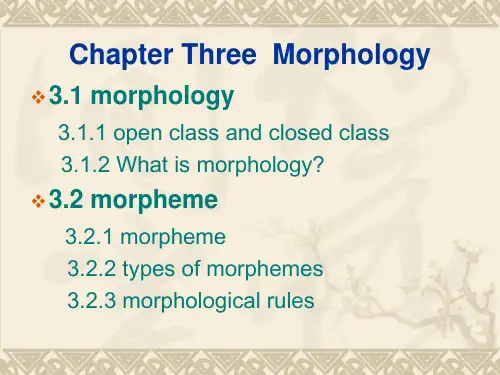
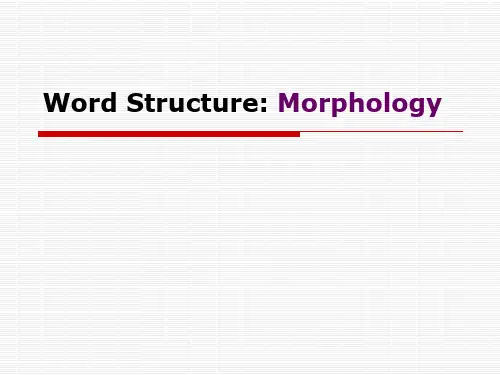
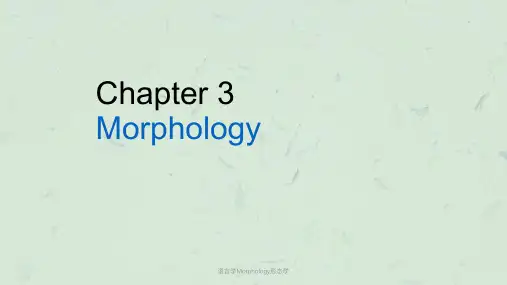

Chapter 3 Morphology 形态学1.Definition 定义Morphology is a branch of grammar which studies the internal structure of words and the rules by which words are formed.形态学是语法学的一个分支,它研究的是单词的内在结构及单词的构成规则。
The aim of morphology is to find out these rules.形态学的任务就是要找出这些规则(单词构成的规则)。
Morphology is divided into two sub-branches: inflectional morphology and lexical or derivational morphology. The former studies the inflections and the latter the study of word-formation.形态学可以划分两个分支:屈折形态学和词汇形态学(也叫派生形态学)。
前者研究的是单词的屈折变化,后者研究的是构词法。
2.Morpheme 词素Morpheme: the smallest meaningful unit of language 词素:语言中最小的意义单位Just as a phoneme is the basic unit in the study of phonology, so is a morpheme the basic unit in the study of morphology.正如音位是音系学研究中的基本单位一样,词素是形态学研究中的基本单位。
Monomorphemic words 单词素单词Types of morphemes 词素的类型Free morphemes 自由词素The morphemes that are independent units of meaning and can be used freely all by themselves are called free morphemes. Such as help, table,room, mate, quick, able.这些词素是独立的、可以自由使用的意义单位,所以它们就被称作自由词素。

现代语言学名词解释现代语言学名词解释现代语言学一绪论1 Linguisitics :Linguistics is generally defined as the scientic study of language2 Phonetics : The study of sounds which are used in linguistics communication is called phonetics.For example,vowels and consonants3 Pho nology” : The study of how sounds are put together and used in communication is called phonology.For example,phone,phoneme,and allophone.4 Morphology :The study of the way in which morphemes are arranged to form words is called morphology.For example,boy and “ish”---boyish, teach---teacher.5 Syntax : The study of how morphemes and words are combined to form sentences is called syntax.For esample,”John like linguistics.”6 Semantics: The study of meaning in language is called semantics. For example,:The seal could not be found.The zoo keeper became worried.” The seal could not be found,The king became worried.” Here the word seal means different things.7 Pragmatics: The study of meaning in context of use is called pragmatics.For example, “I do” The word do means different context.8 Sociolinguistics: The study of language with reference to society is called sociolinguistics.For example,regional dialects,social variation in language.9Psycholinguistics: The study of language with reference to workings of mind is called psycholinguistics.二音系学1 Phonetics: The study of sounds that are used in linguistic communication is called phonetics.2 Phonology: The study of how sounds are put together and used in communication is called phonology.3 Phone: Phone can be simply defined as the speech sounds we use when speaking a language. A phone is a phonetic unit or segement. It does not necessarily distinguish meaning; some do,some don’t.4 Phoneme: Phonology is concerned with the speech sounds which distinguish meaning. The basic unit in phonology is called phoneme;it isa unit that is of distinctive value.5 allophone: The different phones which can represent a phoneme in different phonetic environment are called the allophones of that phoneme.6 Complementary distribution: These two allophones of the same phoneme are said to be in compkenebtary distribution.7 Minimal pair: When two different forms are identical in every way except for one sound segement which occurs in the same place in the stings, the two words are said to form a minimal pair.8 Stress: When a certain syllable of a word is stressed, it means that the syllable is prounced with great force than the other or others.9 tones: Tones are pitch variation, which are caused by the different rates of vibration of the vocal cords. Pitch variations can distinguish meaning just like phoneme; therefore, the tone is a suprasegemental feature.10 intonation: When pitch, stress and sound length are tied to the sentence rather than the word in isolation, they are collectively known as intonation. Intonation plays an important role in conveying meaning in almost every language,especially in a language like English三形态学1 morphology: Morphology is a branch of grammer which studies the internal structure of words and the rules by which words are formed.2 inflectional morphology: Inflectional morphology studies the inflections of word-formation.3 derivational morphology: Derivational morphology is the study of word-formation.4 morpheme: Morpheme is the smallest meaningful unit of language.5 free morpheme: Free morpheme are the morphemes which are independent units of meaning and can be used freely all by themselces or in combination with other morphemes.6 bound morpheme: Bound morphemes are the morphemes which cannot be used independently but have to be combined with other morphemes, either free or bound, to form a word.7 root: A root is often seen as part of a word; it can never stand by itself although it bears clear,definite meaning; it must be combined with another root or an affix to form a word.8 affix: Affixes are of two types: inflectional and derivational.9 prefix: Prefix occur at the beginning of a word.10 suffix: Suffixes are added to the end of the stems; they modify the meaning of the original word and in many cases change its part of speech.11 derivation: Derivation affixes are added to an existing form to creat a word.Derivation can be viewed as the adding of affixes to stem to form nes words.12 compounding: Like derivation, compounding is another popular and important way of forming new words in English. Compounding can be viewed as the combination of two or sometimes more than two words to creat new words.四句法学1 linguistic competence:Comsky defines competence as the ideal user’s knowledge of the rules of his language,and performance the actual realization of this knowledge in linguistic communication.2 sentence : A sentence is a structurally independent unit that usually comprises a number of words to form a complete statement question or command.3 transformation rules: Syntactic movement is governed by transformational rules. The operation of the transformational rules may change the syntactic representation of a sentence.4 D-structure : A sentence may have two levels of syntactic representation. One exists before movement take place, the other occurs after movement take place. In formal linguistic exploration, these two syntactic representation are commonly termed as D-structure.5 Move а : Just as there is a general rule for all phrase structure rules,i,e. the X-bar schema, there is a general movement rule accounting for the syntactic behavior of any constituent movement. This movement rule is cal led Move а五语义学1 semantics: Semantics can be simply defined as the study of meaning in language.2 sense : Sense is concerned with the inherent meaning of the linguistic form. It is the collection of all the features of the linguistic form; it is abstract and decontextualized.3 reference : Reference means what a linguistic form refers to in the real, physical world; it deals with the relationship between the linguistic element and the non-linguistic world of experience.4 synonymy : Synonymy refers to the sameness or close similarity of meaning. Words that are close in meaning are called synonymy.5 polysemy : Polysemy refers to the fact that the same one word may have more than one meaning.A word having more than one meaning is called a polysemic word.6 antonymy : Antonymy refers to the oppositeness of meaning. Words that are opposite in meaning are called antonyms.7 homonymy : Homonymy refers to the phenomenon that words having different meanings have the same form,i.e. different words are identical in sound or spelling, or in both.8 hyponymy : Hyponymy refers to the sense relation between a more general, more inclusive word and a more specific word.9 componential analysis : Componential analysis is a way to analyze wprd meaning. It was proposed by structural semanticists.10 grammatical meaning : The grammatical meaning of a sentence refers to its grammaticality,i.e. its grammatical well-formedness. The grammaticality of asentence is governed by the grammatical rules of the language.11 semantic meaning : The semantic meaning of a sentence is governed by rules called selectional restrictions.12 predication : In semantic analysis of a sentence, the basic unit is called predication. The predication is the abstraction of the meaning of a sentence.七历史语言学1 historical linguistics: Historical linguistics is the subfield of linguistics that studies language change.2 apocope: Another well-documented sound loss is the deletion of a word-final vowel segement, a phenomenon called apocope.3 epenthesis: A change that involves the insertion of a consonant or vowel sound to the middle of a word is known as epenthesis.4 metathesis: Sound change as a result of sound movement is known as metathesis.5 compounding: Compounding is a process of combining two or more words into one lexical unit.6 derivation: Derivation refers to the process by which new words are formed by the addition of affixes to the roots.7 blending: Blending is a process of forming a new word by combining parts of other words.8 back-formation: Back-formation is a process by which new words are formed by taking away the suffix of anexisting word.9 semantic broadening: Semantic broadening refers to the process in which the meaning of a word becomes general or inclusive than its historically earlier denotation..10 semantic narrowing: Semantic narrowing is a process in which the meaning of a word becomes less general or inclusive than its historically earlier meaning.11 semantic shift: Semantic shift is a process of semantic change in which a word loses its former meaning and acquire a new, sometimes related, meaning.12 protolanguage: It refers to a family of a language.13 sound shift: It refers to the systematic modification of a series of phonemes.absee管理员UID 5精华0积分3990 帖子1111 阅读权限200注册2007-6-4状态离线#8使用道具发表于2007-7-26 21:20 资料个人空间短消息加为好友八社会语言学1 sociolinguistics: Sociolinguistics is the study of language in social context.2 speech community: A speech community is thus defined as a group of people who form a community and share the same language or a particular variety of language.3 speech variety: Speech variety, also known as language variety, refers to any distinguishable form of speech used by a speaker or group of speakers.4 language planning: One way out of the communication dilemma is language standardization known as language planning. This means that certain authorities, such as the government or government agency of a country, choose a particular speech variety and spread the use of it, including its pronunciation and spelling system, across regional boundaries.5 idiolect: Such a personal dialect is refered to as idiolect.6 standard language: The standard language is a superposed, socially prestigious dialect of language. It is the language employed by the government and the judiciary system,used by the mass media.7 nonstandard language: Language varieties other than the standard are called nonstandard, or vernacular, languages.8 lingua franca: A lingua franca is a variety of language that serves as a medium of communication among groups of people for diverse linguistic backgrounds.9 pidgin: A pidgin is a variety of language that is generally used by native speakers of other languages as a medium of communication.10 Creole: A Creole language is originally a pidgin that has become established as a native language in some speech communication.11 diglossia: Diglossia usually describes a situation in which two very different varieties of language co-exist in a speech communication, each with a distinct range of purely social function and appropriate for certain situations.12 bilingualism: Bilingualism refers to a linguisticsituation in which two standard languages are used either by an individual or by a group of speakers, such as the inhabitants of a particular region or a nation.13 ethic dialect: An ethnic language variety is a social dialect of a language ,often cutting across regional differences.14 sociolect: Social dialect, or sociolects, are varieties of language used by people belonging to particular social classes.15 register: Registers are language varieties which are appropriate for use in particular speech situations, in contrast to language varieties that are associated with the social or regional grouping of their customary users. For that reason, registers are also known as situational dialects.16 slang: Slang is a causal use of language that consists of expressive but nonstandard vocabulary, typically of arbitrary, flashy and often ephemeral coinage and figure of speech characterized by spontaneity and sometimes by raciness.17 tabo A linguistic taboo refers to a word or expression that is prohibited by the “polite” society from general use.18 euphemism: Euphemism comes from the Greek word euphemismos, meaning “to speak with good words”. A euphemism, then ,is mild, indirect or less offensive word or expression substitute when the speaker or writer fears more direct wording might be harsh, unpleasantly direct, or offensive.absee管理员UID 5精华0积分3990 帖子1111 阅读权限200注册2007-6-4状态离线#9使用道具发表于2007-7-26 21:20 资料个人空间短消息加为好友九心理语言学1 psycholinguistics:Psycholinguistics is the study of language in relation to the mind. As the suggests, psycholinguistics is viewed as the intersection of psychology and linguistics, drawing equally upon the language we acquire, produce and comprehend.2 cerebral cortex: The most important part of the brain is the outside surface of the brain, called the cerebral cortex.3 brain lateralization: The localization of cognitive of cognitive and percpetual functions in a particular hemisphere of the brain is called lateralization.4 linguistic lateralization: In their research of brain lateralization, psycholinguistics are particulary interested in linguistic lateralization, which is the brain’s neurological specialization for language.5 dichotic listening: Evidence in support of lateralizationfor language in the left hemisphere comes from researches in dichotic listening tasks6 right ear advantage: Stimuli heard in the left ear are reported less accurately than those heard in the right car. This phenomenon is knowas the right ear advantage.7 critical period hypothesis: The critical period hypothesis refers to a period in one’s life extending from about age two to puberty during which the human brain is most ready to acquire a particular language and language learning can proceed easily, swiftly and without explicit instruction.8 linguistic determinism: Whorf proposed first that all higher levels of thinking are dependent on language. That is, language determines thought, hence the strong notion of linguistic determinism.9 linguistic relativism: Whorf also believed that speakers of different language perceive and experience the world differently, that is, relative to their linguistic background, hence the notion10 subvocal speech: When language and thought are identical or closely parallel to each other, we may regard thought as “subvocal speech”.of linguistic relativism.absee管理员UID 5精华0积分3990 帖子1111 阅读权限200注册2007-6-4状态离线#10使用道具发表于2007-7-26 21:20 资料个人空间短消息加为好友十语言习得1 language acquisition: Language acquisition is concerned with language development in humans. In general, language acquisition refers to children’s development of their first language, that is, the native language of the community in which a child has been brought up.2 telegraphic speech: The early multiword utterance of children have a special characteristic. They typically lack inflectional morphemes and most minor lexical categories. Because of their resemblance to the styly of language found in telegrams, utterance at this acquisition stage are often called telegraphic speech.3 holophrastic sentence: Children’s one-word utterance are also called holophrastic sentences.4 acquisition: According to Krashen,acquisition refers to the gradual and subconscious development of ability in thefirst language by using it naturally in daily communicative situations.5 learning: Learning, however, is defined as a conscious process of accumulating knowledge of a second language usually obtained in school settings.6 language transfer: Learners will subconsciously use their L1 knowledge in learning a second language. This is known as language transfer.7 positive transfer: Presumably, positive transfer occurs when an L1 pattern is identical with, or similar to, a target-language pattern.8 negative transfer: Conversely, negative transfer occurs when an L1 pattern is different from the counterpart pattern of the target language.9 contrastive analysis: The Contrastive Analysis approach was founded on the belief that, by establishing the linguistic differences between the native and target language system, it was possible to predict what problems learners of a particular second language would face and the types of errors they would make.10 interlanguage: SLA is viewed as a process of creativeconstruction, in which a learner constructs a series of internal representati ons that comprises the learner’s interim knowledge of the target language, known as interlanguage.11 formal instruction: Formal instruction occurs in classrooms when attempts are made to raise learner’s consciousness about the nature of target language rules in order to aid learning.12 instrumental motivation: Thus, instrumental motivation occurs when the learner’s goal is functional.13 integrative motivation: Integrative motivation occurs when the learner’s goal is social.14 acculturation: A related issue with integrative motivation has been the extent to which learners differ in the process of adapting to the new culture of the12community. This adaptation process is called acculturation.。
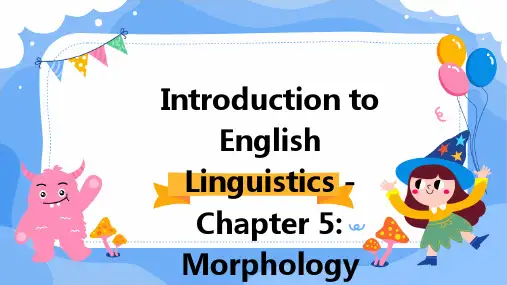

morphology名词解释Morphology是语言学的一个重要分支,主要研究词形变化及其规律。
通俗地说,它关注的是词汇的构成和变化规则。
在语言学中,Morphology与其他语言层次如音韵学、句法学、语义学等密不可分。
一、Morphology的含义及分类Morphology来源于希腊文,意为“形态学”。
传统上,Morphology可以分为屈折语言和孤立语言。
屈折语言是指通过词形变化来表达语法变化的语言,例如德语、拉丁语、日语等。
而孤立语言则是指没有词形变化而通过词序和上下文来表达语法关系的语言,例如汉语、越南语、泰语等。
二、Morphology的研究方法Morphology的研究方法有两种:归纳法和演绎法。
归纳法是通过大量的数据来发现规律,从而得到结论;演绎法则是通过已知的规律推导出新的结论。
此外,Morphology的研究方法也包括对比分析、实证研究等。
三、Morphology的重要性Morphology在语言学中占有重要地位。
它不仅可以协助我们理解语言,还可以帮助我们分析语言的结构和变化规律。
在语言教学中,Morphology也具有重要的应用价值。
它可以帮助学生更好地掌握语法规则,提高语言表达能力,同时也可以帮助学者更好地创造新词汇和语法结构。
四、Morphology的研究对象Morphology研究的主要对象是单词及其构成形式。
单词是语言的基本单位,是形式与意义相结合的最小单位。
在不同的语言中,单词的构成形式可能包括前缀、后缀、词根、词缀、复合词等。
五、Morphology的研究内容Morphology研究的主要内容包括词素结构、词形变化和词汇的构成规则。
词素是单词的最小单位,它是具有一定语义的字或字组合。
词素结构指的是一个单词内部各个词素的组成方式。
词形变化是指单词在不同语法环境下形态的变化,例如英语的时态、语态、比较级等。
词汇构成规则是指单词的构成方式以及单词之间的关系,例如英语中的复合词、派生词等。
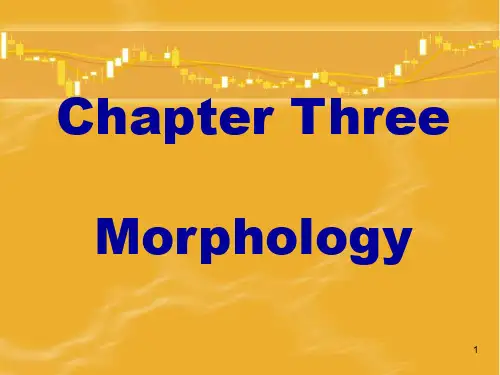
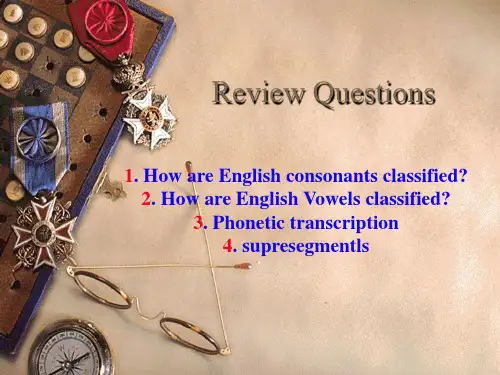
morphology语言学定义【形态学morphology】是语法学的一个分支,研究单词的内部结构和构词规则。
形态学有两个分支:曲折形态学和词汇或派生形态学。
曲折形态学研究语法曲折和语法意义的形态学;派生形态学研究单词的构成和词义的表达。
morphology什么意思?1、词法:词法研究的对象是各种词的形式及其用法. 英语词类的形式变化有:名词和代词的数,格和性的形式变化;动词的人称、时态、语态、语气等形式变化;以及形容词和副词比较等级的形式变化。
2、句法(syntax)句法研究的对象是句子各个组成部分及其安排的规律,。
3、构词学:构词学(morphology)是语言学中的一门比较简单的学问,主要研究的是词的构成. 最近几年,电脑领域的某些词汇有了一些改变,某些词汇渐渐不被人们使用,新的词汇取而代之. 例如说,以前我们说「执行」一个程式,现在则说「跑」一个程式。
资料拓展:morphology.n.形态学,形态论;词法,词态学。
短语:soil morphology土壤形态学;土壤形态。
urban morphology城市形态;城市形态学。
例句:And morphology and performance of the coating has been examined. 并对镀层的表面形貌和性能进行了测定。
We also analyzed the effect of morphology on field emission properties.我们还分析了形貌对场发射性能的影响。
He also gave a very accurate description of the morphology of his cells.他给他所发现的.细胞的形态学特征进行了非常精细的描述。
They attain complex morphology, appearing as branched, tubular processes.它们达到复杂的形态,出现分枝,管状突起。
Chapter 4: MorphologyLearning Objectives⏹I. Definition of word and word classification⏹II. Morphology & morpheme⏹III. Word formation rulesI. Words⏹Lexicon: the mental dictionary❑Cf. Vocabulary⏹How many words are there in English?❑In Webster’s Third International Dictionary of the English Language, more than 450,000 entries are listed.What is Word?⏹ A Vague definition:❑ A unit of expression that has universal intuitive recognition by native speakers, whether it is expressed in spoken or written form.⏹Three senses are involved in defining “word”, none of which is satisfactory.Three Senses of “Word”1. A physical unit:⏹ a cluster of sound segments or letters between two pauses or blanks, e.g.❑Phonological:❑Orthographic: It is wonderful.❑Three words are recognized.⏹However, in casual speech or writing, it often becomes:❑Phonological:❑Orthographic: It’s wonderful.❑Are they two words or three?2. A Lexical item or a lexeme⏹ A lexical item is an entry in a dictionary.⏹Problem: A lexeme WRITE includes all of its grammatical forms:❑write, writes, writing, wrote, written3. A grammatical unit:sentenceclausephrasewordmorpheme⏹Problem: love; hateIdentification of Words1. Stability:⏹stable linguistic units.⏹chairman, but not *manchair2. Relative uninterruptibility:⏹cannot pause and add another component in between, as in *disinterestappointment.⏹But we can add another word between words: Paul, (John) and Mary ...3. A minimum free form:⏹the smallest unit that can constitute a complete utterance by itself, e.g.⏹—Is Jane coming tonight?⏹—Possibly.⏹Hi.⏹Wonderful.Question: Can articles be independent?Word Classification1. Variable words vs. invariable words⏹Criterion:❑with or without inflective changes⏹Examples:❑follow since❑cat when❑nice through2. Content words vs. function words⏹Content words:❑nouns, verbs, adjectives, and adverbs.⏹Function words:❑conjunction, preposition, articles, pronouns, etc.⏹Criterion:❑With or without semantic content3. Closed-class words vs. open-class words⏹Criterion:❑Whether the membership is fixed or limited⏹Question: What are the relationships among the three classifications?Word Class⏹Word class is also known as Parts of Speech in traditional grammar.❑Noun, verb, adjective, adverb, preposition, pronoun, conjunction, interjection, article, etc.⏹Some new terms in word class:❑ 1. infinitive to, negative not, subordinate units in phrasal verbs “get by”, “look back”, etc.❑ 2. do, have, be❑ 3. can, will, may, must, etc.particles, auxiliaries, & modal verbs❑ 4. Pro-forms: substitutes for other terms.✧Pronoun: he, she, I, they, everyone✧Pro-adjective: Your car is red. So is his.✧Pro-verb: He speaks English better than he did.✧Pro-adverb: He hopes to win and I hope so too.✧Pro-locative: He went there.❑ 5. Determiner: all the articles, demonstratives, and quantifiers that appear before the noun and its modifiers.✧As many as three determiners may be used in each case and there isa fixed order when there is more than one.II. Morpheme: the minimal unit of meaning⏹ A. “They gave it me,”Humpty Dumpty continued, “for an un-birthday present.”⏹ B. “I beg your pardon?”Alice said with a puzzled air.⏹ A. “I am not offended,”said Humpty Dumpty.⏹ B. “I mean what is an un-birthday present?”⏹ A. “A present given when it isn’t your birthday, of course.”——Lewis Carrol, Through the Looking-GlassA B⏹desirable undesirable⏹likely unlikely⏹inspired uninspired⏹developed undeveloped⏹“In two words: impossible!” –your comment?Definition of Morpheme⏹Morpheme:❑the smallest unit of language in terms of relationship between expression and content, a unit that cannot be further divided without destroying ordrastically changing the meaning, whether it is lexical or grammatical.⏹In spoken language, morphemes are composed of phonemes, and in written languagemorphemes are composed of graphemes (字素).Morphs and Allomorphs⏹Morphs:❑are the phonological or orthographic forms which realize morphemes, and they are minimal carriers of meaning.⏹The different morphs of one morpheme are called the morpheme’s allomorphs.The plural morpheme⏹The alternates /-z/, /-s/, /-I z/, /-Iα-/, /-:ι-/, /∅/ are all morphs of the same pluralmorpheme. That is, they are all allomorphs of the plural morpheme.⏹Question: What are the allomorphs of the past tense morpheme?❑Answer: Orthographic allomorphs are –d, -ed, and other forms correspondent to irregular verbs, phonological allomorphs are /-t/, /-d/, and/-I d/.Practice: How many morphemes?⏹boyishness❑boy+ish+ness⏹unfriendliness❑un+friend+ly+ness⏹gentlemanliness❑gentle+man+li+ness⏹antidisestablishmentarianism❑anti+dis+establish+ment+ari+an+ismWord vs. Morpheme⏹One morpheme:❑boy; desire⏹Two morphemes:❑kill+er; desire+able⏹Three morphemes:❑desire+able+ity⏹Four morphemes:❑un+desire+able+ity⏹More than four:❑un+gentle+man+li+nessMorpheme Classification⏹Free vs. Bound morphemes:❑Free morphemes: those that may constitute words by themselves❑Bound morphemes: those that cannot occur alone⏹Examples:❑ e.g. boy, girl, table, nation❑ e.g. -s, -ed, dis-, un-⏹Affix: the type of formative that can be used only when added to another morpheme.Normally divided into❑prefix (dis-, un-)❑suffix (-en, -ify)❑infix (?)✧Is “foot---feet”an example of infixation?⏹Root:❑the base form of a word that cannot be further analyzed without total loss of identity, e.g. friend as in unfriendliness.⏹Roots may be:❑free: those that can stand by themselves, e.g. black+board; nation+-al; or❑bound: those that cannot stand by themselves, eg -ceive in receive, perceive, conceive.⏹Stem: a morpheme or combination of morphemes to which an affix may be added⏹ e.g. friend+-s; write+-ing, possibility+-es.⏹Derivation:❑combination of a base and an affix to form a new word, e.g. friend+-ly > friendly.⏹Inflection:❑grammatical endings, e.g. plural, tense, comparative, etc. Inflectional Affixes/morphemes⏹How many possible inflectional affixes are there in the English language?❑Nouns:✧John—John’s; cat—cats❑Adjective:✧clear—clearer; clearest❑Verbs:✧write—writes; wrote; written; writingMorpheme ClassificationComparing inflectional and derivational morphemes⏹ 1. In terms of productivity⏹ 2. Whether the word class of the stem is changed or not⏹ 3. Grammatical need vs. semantic need⏹ 4. derivational morpheme + inflectional morpheme order⏹ 5. Suffix: derivational + inflectional; prefix: derivationalMorphology⏹The Definition:❑the study of word-formation, or the internal structure of words, or the rules by which words are formed from smaller components, that is, morphemes.Derivational Morphology/Word Formation⏹Two basic ways:Compounding⏹Two or more free roots combine to make a new word.❑Noun compounds: daybreak, playboy, haircut, windmill❑Verb compounds: brainstorm, lipread, babysit❑Adjective compounds: gray-haired, insect-eating, dutyfree❑Preposition compounds: into, throughout⏹Endocentric & exocentric❑Endocentric: one element serves as the head, the relationship of “a kind of”;e.g.⏹self-control: a kind of control⏹armchair: a kind of chair❑Exocentric: there is no head, so not a relationship of “a kind of something”,e.g.⏹scarecrow: not a kind of crow⏹breakneck: not a kind of neck⏹Written forms of compounds❑Solid: blackboard, teapot, bodyguard❑Hyphenated: wedding-ring, wave-length❑Open: coffee table, washing machine⏹Free variation:❑businessman, business-man, business man❑winebottle, wine-bottle, wine bottle❑no one, no-one, nooneDerivation⏹Class-changing:❑N>V: lengthen, hospitalize, discard❑N>A: friendly, delightful, speechless❑V>N: worker, employee, inhabitant❑V>A: acceptable, adorable❑A>N: rapidness, rapidity❑A>V: deafen, sweeten❑Adj>Adv: exactly, quickly⏹Class-preserving:❑N>N: nonsmoker, ex-wife, booklet❑V>V: disobey, unfasten❑A>A: grayish, irrelevantHierarchical Structure of Words⏹system-systematic-unsystematic⏹Morphological rules: noun + atic = adj.un + adjective = adj.Tree Diagramlock-lockable-unlockableStructural analysis⏹boyish⏹undesirable⏹unfriendliness⏹inactivate⏹ungentlemanlinessIII. Word-formation through lexical change⏹ 1. Invention/Coinage❑Mostly brand names:❑Kodak, Coke, nylon, Band-aid, Xerox, Lycra❑transfer+resistor>transistor❑smoke+fog>smog❑motorist+hotel>motel⏹ 2. Blending❑breakfast+lunch>brunch❑modulator+demodulator>modem❑dance+exercise>dancercise❑advertisement+editorial>advertorial❑education+entertainment>edutainment❑information+commercial>infomercial❑diagnose < diagnosis❑enthuse < enthusiasm❑laze < lazy⏹ 3. Back-formation❑liaise < liaison❑reminisce < reminiscence❑statistic < statistics❑televise < television❑burgle, commentate, edit, peddle, scavenge, sculpt, swindle❑air-condition, babysit, brainstorm, brainwash, browbeat, dry-clean, house-hunt, housekeep, sightsee, tape-record❑articulate, assassinate, coeducate, demarcate, emote, intuit, legislate,marinate, orate, vaccinate, valuate⏹ 4. Abbreviations❑ad(vertisement), exam(ination), (omni)bus⏹ 5. Clipping❑Back-clippings: chimp(anzee), deli(catessen), hippo(potamus), lab(oratory), piano(forte), reg(ulation)s❑Fore-clippings: (ham)burger,, (violin)cello, (heli)copter, (alli)gator, (tele)phone, (earth)quake❑Fore-and-aft clippings: (in)flu(enza), (de)tec(tive)❑AIDS, Aids: Acquired Immune Deficiency Syndrome❑ASAP: as soon as possible⏹ 6. Acronym❑CD-ROM: compact disc read-only memory❑WASP: white Anglo-Saxon protestant❑dink(y): double income, no kids❑nilk(y): no income, lots of kids⏹7. Initialism❑AI: artificial intelligence❑ECU: European Currency Unit❑HIV: human immunodeficiency virus❑PC: personal computer❑PS: postscript❑RSVP: répondez s’il vous plait (‘please reply’in French)⏹8. Analogical creationFrom irregular to regular:❑work: wrought > worked❑beseech: besought > beseeched❑slay: slew > slayed?❑go: went > goed???⏹9. Borrowing❑French:administration, parliament, public, court, crime, judge, army, enemy, officer, peace, soldier, war, faith, religion, coat, costume, dress,fashion, jewel, dinner, feast, fry, roast, supper, toast, customer, money, price,art, college, music, poet, prose, story, study❑Latin:admit, client, conviction, discuss, equal, index, library, medicine, minor❑Greek: catastrophe, cosmos, criterion, idiosyncrasy❑Spanish and Portuguese: banana, barbecue, cafeteria, cargo, chocolate, cigar, cocaine, cockroach, cocoa, guitar, mosquito, negro, potato, tank, tobacco,tomato, vanilla❑Italian: aria, bandit, broccoli, casino, concerto, duet, finale, influenza, mafia, malaria, paparazzi (singular paparazzo), piano, pizza, solo, soprano,spaghetti, studio, umbrella, volcano❑Dutch: boss, brandy, cookie, cruise, deck, dock, dollar, freight, gin, kit, knapsack, landscape, luck, sketch, slim, smuggle, snap, trek, yacht ❑Arabic: admiral, alchemy, alcohol, algebra, alkali, almanac, assassin, candy, hazard, lemon, magazine, safari, sofa, zero❑Indian: bungalow, cashmere, curry, ginger, jungle, mango, polo, pyjamas (or pajamas), shampoo, swastika, thug, yoga❑Chinese: chop suey, chow, chow mein, ginseng, gung-ho, ketchup (or catchup or catsup), kung fu, tea, tofu (via Japanese), typhoon⏹Question: Why does English borrow extensively from many different languages?Development of EnglishTypes of loan words⏹ a. Loanwords:❑au pair, encore, coup d’etat, kungfu, sputnik⏹ b. Loanblend:❑coconut: coco (Spanish) + nut (English)❑Chinatown: China (Chinese) + town (English)⏹ c. Loanshift:❑bridge: meaning as a card game borrowed from Italian ponte⏹ d. Loan translation, or calque:❑free verse < L verse libre❑black humor < Fr humour noir❑found object < Fr objet trouvéExercisesI. What are the morphological process involved in the three columns?Reference answer⏹Column I: ablaut (vowel modification) (元音交替)⏹Column II: suppletion (total change of form) (异干法)⏹Column III: stress modification (重音变化)II. The English suffix –er can be added to some place names but not to some other place names.⏹Column A Column B⏹Londoner *Torontoer⏹Vermonter *Miamier⏹New Yorker *Denverer⏹Newfoundlander *Philadephiaer⏹Long Islander *San FranciscoerQuestions1. In general terms, what does the suffix mean in the words in Column A?2. What is the constraint on the distribution of the suffix –er?Answers⏹ 1. The suffix means “the inhabitant of”.⏹ 2. The –er suffix must be added to a noun which ends with a consonant.III. The following words are from Dutch⏹ 1. State the morphological rule for forming an infinitive in Dutch.⏹ 2. State the morphological rule for forming the Dutch past participle form.Reference answer⏹ 1. To form an infinitive, add the suffix “-en”to the root.⏹Infinitive = Root + en⏹ 2. To form a past participle, circumfix the prefix “ge-”and the suffix “-d”to theroot.⏹Past Participle = ge + Root + dIV. Morphological processes may be sensitive to certain phonological context. Please state the phonological contexts where the addition of “-en” is possible.Reference answer⏹The suffix “-en”, which attaches to adjectives to form verbs, can only attach tomonosyllabic bases ending in obstruents.⏹Meaning: to make (more) “adjective”。